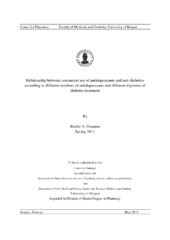| dc.description.abstract | Both diabetes and depression are enormous health problems. Several chronic illnesses are co-morbid with depression, and diabetes is not an exception. Scientists and epidemiologists have long been conducting research on the relationship between diabetes and depression. Several epidemiological studies confirm this relationship. Aim: The aim of this project was to investigate this relationship between concurrent use of antidepressants and antidiabetic in users of different numbers of antidepressants and different regimens of diabetes treatment. Methodology: The study is a cross-sectional design; Data on prescribed and dispensed medication from 2006 obtained from all pharmacies across Norway, supplied by the Norwegian Prescription database are the source of material in this study. The database was pseudonymized upon reception. Therefore, data cannot integrally be traced back to any individual. There was therefore no need to involve the Regional or Local Committee for Medical Research Ethics nor the Norwegian Data Inspectorate since the database is properly secured. However, permission to use the data was obligatory. Individuals between 20 and 79 years of age are the subjects selected from the database and categorized into users of insulin only, those who received oral anti-glycaemia agents only and those who received both insulin and oral anti-glycaemia agents. Individuals were further categorized according to; whether received single type, multiple types or no antidepressants. Odds ratio was then calculated and adjusted for age and gender using binary logistic regression. Results: The odds ratio of using single antidepressants were 1.5 times higher among individuals who received insulin only and individuals who received oral anti glycaemic only compared to the general population (OR =1.55, 95% CI: 1.49-1.62 and OR=1.56, 95% CI: 1.52-1.60 respectively). Individuals who received both insulin and oral anti glycaemic agents had twice the risk of using single antidepressants compared to the general population; (OR=2.0, 95% CI: 1.90-2.11). In the usage of multiple antidepressants, users of insulin only had also 1.5 times the risk compared to the general population (OR=1.52, 95% CI: 1.38-1.66). Users of oral anti glycaemic agents only had 1.8 times the risk compared to the general population (OR=1.84. 95% CI: 1.74-1.94). The risk was significantly higher than the risk of single antidepressants usage and shows that multiple antidepressants usage is more common among these individuals compared to the general population. The risk was also higher among individuals who received both insulin and oral glycaemic agents (OR=2.25, 95% CI: 2.04-2.50) compared to the general population. Within age groups; among users of insulin only, individuals of age group 50-59 had the highest risk (OR=1.78, 95% CI: 1.62-1.95) of using single antidepressants compared to the general population. Among users of oral anti glycaemic only, age groups 30-59 had the highest risk (1.8-2.4 times) compared to the general population. The odds ratio for individuals who received both insulin and oral anti glycaemic agents was also higher among age groups 20-59 (2-4.5 times) compared to the general population. The risk for individuals who received both insulin and oral anti glycaemic agents was higher than the risks for users of insulin only and users of oral anti glycaemic agents only. The risk of using multiple antidepressant among users of insulin only was higher (2 times) among age groups 20‐39 compared to the general population. Among individuals of oral anti glycaemic only, age groups 20‐59 had higher significant risks (2‐3 times) in using multiple antidepressants compared to the general population. Whiles among users of both insulin and oral anti glycaemic agents, individuals of age groups 30‐59 had the highest risk (3‐4.5 times) compared to the general population. Regarding gender, the risk of using multiple antidepressants was higher than the risk in using single antidepressants. Although the prevalence is higher in women than men, there is a negligible difference in the risk of using antidepressants among men than women. Conclusion: The usage of single antidepressants was higher than multiple antidepressants among diabetes individuals as it was for the general population. For individuals using oral antidiabetic agents only, the risk of using multiple antidepressants versus single antidepressants was higher than for the general population. The reason for this needs further study. Although, there are limitations of cross‐sectional studies and secondly, there was no means to adjust for factors as BMI, CHD, smoking and physical activities, the result confirms previous studies suggesting an association between diabetes and depression. | en_US |
